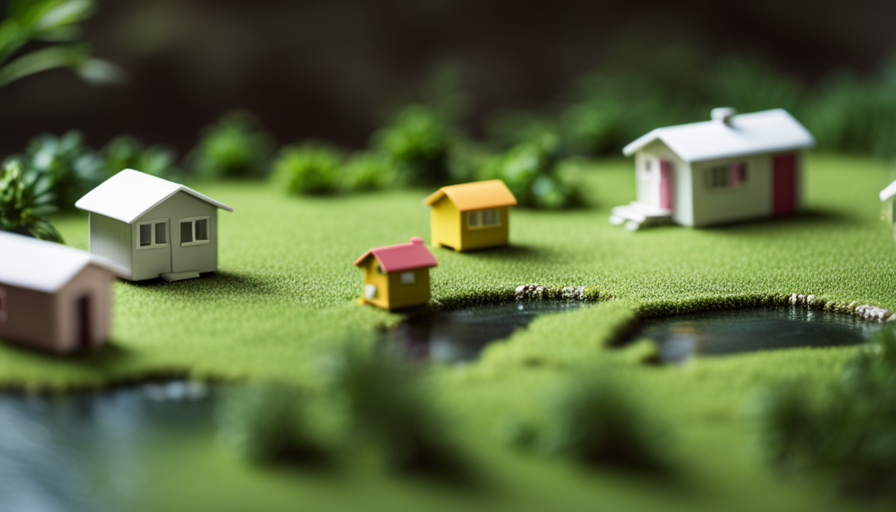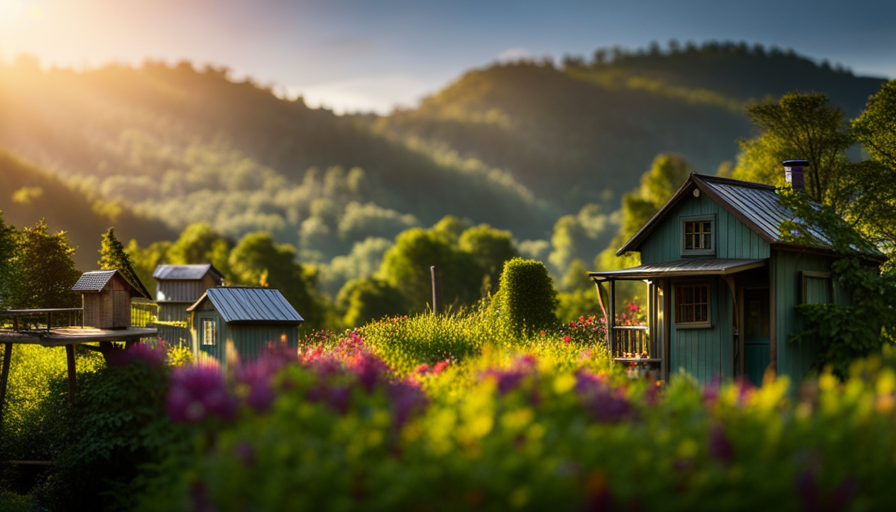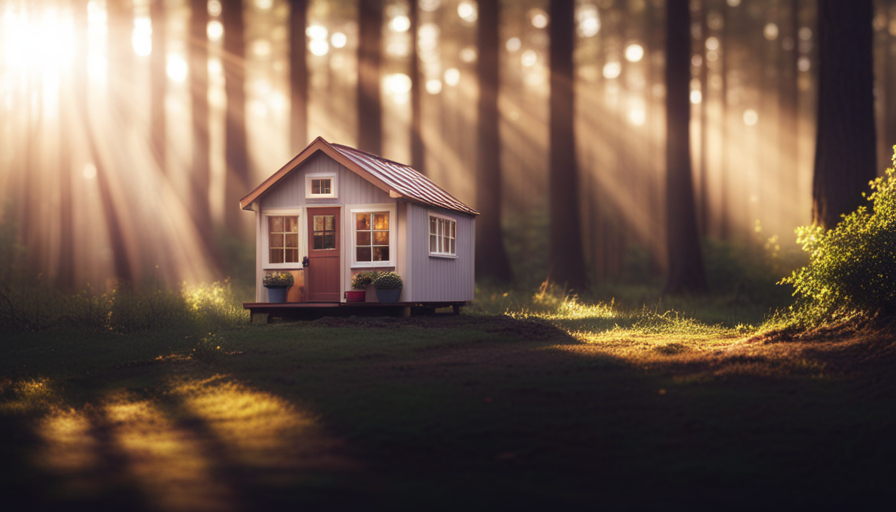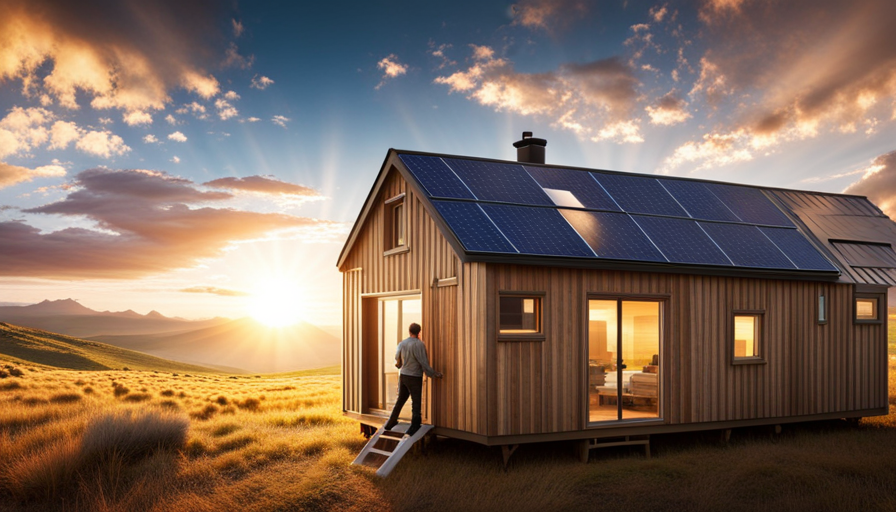Are you looking for ways to make the most of living in a small space? Look no further! This article will guide you through the many options for purchasing a tiny home. Whether you’re interested in a minimalist lifestyle with less clutter or you crave the freedom to travel and explore, there’s a perfect tiny house out there for you. We’ll explore various pathways, from customized tiny house builders to online marketplaces, DIY kits to tiny house communities, to assist you in finding the tiny house of your dreams.
Get ready to embark on a journey where creativity meets functionality, and where a small space can offer big possibilities. With so many options available, it’s easier than ever to find a tiny house that suits your needs and style.
So let’s dive in and discover the world of tiny houses together!
Key Takeaways
- There are multiple options for purchasing a tiny house, including real estate listings, online marketplaces, specialized builders, and alternative housing organizations.
- DIY construction is a viable option for those interested in building their own tiny house, with resources and guides available.
- Living in a tiny house community offers benefits such as financing programs and zoning regulations, and there are popular communities across the United States.
- Tiny house festivals and expos provide inspiration, education, networking opportunities, and financing options, as well as access to experts in the field.
Specialized Tiny House Builders
If you’re searching for a tiny house that’s tailor-made to your specific needs and preferences, you’ll find specialized builders who can bring your dreams to life. Specialized tiny house builders are experts in crafting custom tiny homes that are designed to maximize space and functionality. These builders have years of experience and a deep understanding of the unique challenges and opportunities that come with building tiny houses.
One option is to work with specialized tiny house builders who are part of alternative housing organizations. These organizations are dedicated to promoting sustainable and affordable housing options, and they often have a network of builders who specialize in tiny homes. By working with these builders, you can ensure that your tiny house is not only built to your exact specifications but also meets high standards of quality and sustainability.
Transitioning to the subsequent section about online marketplaces, while working with specialized builders can be a great option, it’s not the only way to purchase a tiny house. Online marketplaces offer a wide range of pre-built tiny homes that are ready to be delivered to your desired location. These marketplaces provide a convenient way to browse through different styles and sizes of tiny houses and compare prices.
Online Marketplaces
When you’re ready to start your journey towards a minimalist lifestyle, there’s no better place to explore unique and affordable living spaces than the vast online marketplaces. These platforms provide a convenient way to connect with specialized tiny house dealers from all over the country, allowing you to browse through a wide range of options without having to travel long distances.
Here are some reasons why online marketplaces are the ideal destination for finding your dream tiny house:
-
Variety: Online marketplaces offer a diverse selection of tiny houses, from cozy cabins to sleek modern designs. You can find a style that suits your preferences and needs.
-
Competitive Pricing: With many sellers competing for buyers’ attention, online marketplaces often offer competitive prices, making it easier to find an affordable tiny house.
-
Financing Options: Many online marketplaces provide financing options, allowing you to spread out the cost of your tiny house over time. This can make the purchase more accessible and manageable for those on a budget.
-
Nationwide Reach: By using online marketplaces, you have access to tiny house dealers from all over the country, increasing your chances of finding the perfect match.
-
Customer Reviews: Online marketplaces often include customer reviews and ratings, giving you valuable insights into the reputation and quality of the sellers.
When it comes to finding your ideal tiny house, online marketplaces offer a convenient and comprehensive solution. However, if you’re feeling more adventurous and want to take a hands-on approach, there are also DIY options available.
DIY Options
If you’re feeling up to the challenge, considering building your own tiny house can be a rewarding and cost-effective option.
There are plenty of resources and guides available that can help you navigate the DIY construction process.
From step-by-step instructions to design ideas and tips, these resources can provide you with the knowledge and support you need to create your own dream tiny home.
Consider building your own tiny house
Consider taking on the challenge of building your very own tiny house and unleash your inner architect. Building your own tiny house can be a rewarding experience that allows you to customize every aspect of your living space.
Before you begin, it’s important to research and obtain the necessary building permits to ensure compliance with local regulations. To keep costs down, consider using cost-effective materials such as reclaimed wood or repurposed materials. This not only reduces expenses but also adds character to your tiny house.
Additionally, there are numerous resources and guides available online that provide step-by-step instructions and tips for DIY construction. These resources can help you navigate the building process and make informed decisions along the way.
With careful planning and the right resources, you can create a beautiful and functional tiny house that perfectly suits your needs.
Find resources and guides for DIY construction
Discover a wealth of online resources and guides that will empower you to confidently tackle the DIY construction of your dream living space.
With the growing popularity of tiny houses, there are numerous websites, blogs, and forums dedicated to providing you with all the information you need to build your own tiny house. These resources offer step-by-step tutorials, detailed plans, and expert advice from experienced builders.
You can find information on everything from selecting the right materials and tools to framing, plumbing, and electrical work. Whether you’re a seasoned DIY enthusiast or a beginner, these resources will guide you through the entire construction process, ensuring that you have the knowledge and skills necessary to create your perfect tiny home.
As you dive into the world of DIY construction, you’ll soon discover that there’s a vibrant community of tiny house enthusiasts eager to share their experiences and knowledge with you.
Tiny House Communities
One popular option for purchasing a tiny house is to explore the various tiny house communities available. These communities provide a unique opportunity to live in a close-knit community of like-minded individuals who appreciate the simplicity and freedom that comes with tiny house living. In addition to the sense of community, many tiny house communities offer amenities such as shared gardens, communal spaces, and access to recreational facilities.
When considering purchasing a tiny house in a community, it is important to research the financing options available. Some communities offer financing programs specifically tailored for tiny house purchases, making it easier to obtain the necessary funds. Additionally, it is crucial to be aware of zoning regulations that may impact where you can park your tiny house. Different communities may have different regulations, so it is important to do your due diligence and ensure that the community you choose is in compliance with local zoning laws.
In order to provide a comprehensive view of the different tiny house communities available, below is a table highlighting four popular communities across the United States:
| Community Name | Location | Amenities |
|---|---|---|
| Community A | California | Shared gardens, gym |
| Community B | Oregon | Communal workspace, pool |
| Community C | Colorado | Dog park, hiking trails |
| Community D | Texas | Community center, lake |
These communities are just a few examples of the many options available to those interested in purchasing a tiny house. By exploring these communities, individuals can find the perfect location to call home and begin their tiny house journey. Looking beyond tiny house communities, another exciting option to consider is attending tiny house festivals and expos, where you can learn more about the different types of tiny houses available and connect with experts in the field.
Tiny House Festivals and Expos
Get ready to immerse yourself in the world of tiny house living by attending exciting festivals and expos that showcase the endless possibilities of this unique lifestyle. These events are a great way to connect with other enthusiasts, learn about the latest tiny house design trends, and explore financing options for your own tiny home.
Here are four reasons why you should consider attending a tiny house festival or expo:
-
Inspiration: Get inspired by the innovative designs and creative solutions that tiny house builders and enthusiasts have come up with. From multi-functional furniture to space-saving storage solutions, you’ll discover new ideas to make the most of your tiny space.
-
Education: Learn from experts in the field who can provide valuable insights on everything from building codes and regulations to off-grid living. Workshops and seminars cover a wide range of topics, giving you the knowledge you need to make informed decisions about your tiny house journey.
-
Networking: Connect with like-minded individuals who share your passion for tiny house living. Exchange ideas, share experiences, and build a supportive community that can offer guidance and support throughout your tiny house adventure.
-
Financing options: Explore different financing options available for purchasing or building your own tiny house. Meet with lenders who specialize in tiny house financing and learn about grants, loans, and other resources that can help you turn your tiny house dream into a reality.
Attending a tiny house festival or expo is just the first step in finding your perfect tiny home. Next, let’s explore real estate listings to see what’s available in your desired location.
Real Estate Listings
When it comes to finding your dream tiny home, take a look at the real estate listings in your desired location to see what options are available for you.
Real estate listings can provide you with a wide range of choices when it comes to purchasing a tiny house. These listings are typically managed by real estate agents who specialize in small homes and can guide you through the process.
One advantage of using real estate listings is that you can easily compare different properties and their features. You can filter your search based on your desired location, size, price range, and other specific preferences. This allows you to find a tiny house that fits your needs and budget.
In addition to the variety of options, real estate listings can also provide information on financing options. Many tiny house builders offer financing packages, and some lenders specialize in tiny house loans. The real estate agents associated with these listings can provide guidance on the financing process and help you find the best option for your situation.
After exploring the real estate listings and finding potential tiny houses, you may also want to consider renting or leasing options. These alternatives can provide flexibility and allow you to experience tiny house living before committing to a purchase.
Renting or Leasing Options
Renting or leasing a tiny house can be a smart move before making the commitment to purchase. It allows you to experience the tiny house lifestyle firsthand and determine if it’s the right fit for you.
Additionally, exploring leasing options for long-term tiny house living can provide a more affordable and flexible alternative to buying.
Consider renting a tiny house before committing to a purchase
Before you jump into buying a tiny house, why not try out the experience by renting one first?
Renting a tiny house has its advantages and disadvantages. On one hand, renting allows you to experience the minimalist lifestyle without the long-term commitment. It gives you the opportunity to see if tiny living is right for you before investing a significant amount of money. Additionally, renting a tiny house can be a great option if you’re unsure about where you want to settle down or if you enjoy traveling frequently.
On the other hand, renting may limit your ability to customize the space to your liking and you might not have as much freedom to make changes. However, renting can still be a valuable way to test the waters and determine if tiny house living aligns with your lifestyle.
Now, let’s explore leasing options for long-term tiny house living.
Explore leasing options for long-term tiny house living
If you’re ready to commit to the minimalist lifestyle, leasing a tiny home for the long-term offers you the chance to fully embrace the freedom and simplicity it provides.
When considering leasing versus buying a tiny house, there are a few key factors to keep in mind. Leasing allows you to test out the tiny house lifestyle without a long-term commitment and provides more flexibility if you decide it’s not for you. Additionally, leasing often includes maintenance and repairs, relieving you of those responsibilities.
When it comes to financing options for long-term tiny house living, some leasing companies offer rent-to-own programs, allowing you to gradually build equity in your tiny home. Others may require a security deposit and monthly rent payments.
Transitioning from the discussion of leasing options, let’s now explore alternative housing organizations.
Alternative Housing Organizations
Although it may seem unconventional, many alternative housing organizations offer affordable options for purchasing a tiny house. These organizations cater to individuals who are interested in living a minimalist lifestyle and want to own their own home without the burden of a traditional mortgage. They often provide alternative housing grants and tiny house financing options to make homeownership more accessible.
To further illustrate the range of options available through alternative housing organizations, consider the following table:
| Organization | Description | Financing Options |
|---|---|---|
| XYZ Housing | Focuses on sustainable living and eco-friendly designs. | Alternative housing grants, rent-to-own |
| ABC Homes | Specializes in customizable tiny homes with modern amenities. | Tiny house financing, leasing |
| 123 Community | Provides affordable housing solutions for low-income individuals. | Rent-to-own, crowdfunding |
These organizations not only offer a variety of housing options but also provide financial assistance to help individuals achieve their dream of owning a tiny house. By exploring these alternative housing organizations, you can find a tiny house that fits your needs and budget.
Moving on to the next section about local classifieds and online forums, you can also discover additional options for purchasing a tiny house.
Local Classifieds and Online Forums
Don’t miss out on the incredible opportunities waiting for you in local classifieds and online forums, where you can uncover hidden gems that will truly make your dreams come true.
These platforms provide a wealth of information and connections to help you find the perfect tiny house. Local classifieds are a great place to start, as they often have listings from local builders who specialize in tiny houses. These builders have the expertise to create unique and customized homes that meet your specific needs. Additionally, local classifieds may also feature financing options, allowing you to explore different ways to fund your tiny house purchase.
Online forums are another valuable resource when searching for a tiny house. They provide a platform for individuals to share their experiences, recommendations, and insights about purchasing a tiny house. You can find discussions about different builders, financing options, and even tips on how to navigate the buying process. By participating in these forums, you can gain valuable knowledge and connect with others who share your passion for tiny living.
Transitioning into the next section about social media groups and networks, you’ll discover even more opportunities to connect with like-minded individuals and learn about available tiny houses.
Social Media Groups and Networks
Get ready to dive into the world of social media groups and networks, where you’ll uncover a treasure trove of connections and knowledge that’ll help you on your quest for a dreamy abode.
Social media platforms have become powerful tools for finding and purchasing tiny houses. These platforms are filled with communities of enthusiasts and experts who can guide you in the right direction.
One way to tap into this network is by following social media influencers who specialize in tiny houses. These influencers have a wealth of knowledge and experience and often share valuable insights, tips, and recommendations. They can direct you to reputable sellers, provide information on the latest trends, and even showcase innovative designs that you may not have considered before.
Another avenue to explore is crowdfunding campaigns. Many individuals and companies use social media to promote their tiny house projects and seek funding from supporters. By engaging with these campaigns, you not only contribute to a worthy cause but also gain access to exclusive offers and discounts. Additionally, you can connect with others who share your passion for tiny living.
Social media groups and networks offer a wealth of resources for finding and purchasing a tiny house. By following influencers and engaging with crowdfunding campaigns, you can tap into a community that’s passionate about tiny living and discover unique opportunities to make your dream of owning a tiny house a reality.
Frequently Asked Questions
Are there any financing options available for purchasing a tiny house?
Yes, there are financing options available for purchasing a tiny house. Financing a tiny house offers various benefits such as flexibility, lower upfront costs, and the opportunity to build equity.
Can I customize the design and layout of a tiny house?
When it comes to tiny houses, the sky’s the limit! With plenty of customization options and design flexibility, you can create a space that is uniquely yours. Let your imagination run wild!
Are there any specific zoning regulations or building codes I need to be aware of when purchasing a tiny house?
When it comes to purchasing a tiny house, it’s crucial to be aware of the specific zoning regulations and building codes in your area. These regulations vary, so it’s important to consult with local authorities to ensure compliance.
How much does it cost to maintain a tiny house?
Maintaining a tiny house is like tending to a delicate bonsai tree; it requires attention and care. The cost breakdown varies, but regular maintenance, such as cleaning, repairs, and utilities, can range from $500 to $1,000 per year. Here are some maintenance tips to keep your tiny house in top shape.
Are there any restrictions on where I can park or place a tiny house?
Parking restrictions and placing limitations vary depending on local regulations and zoning laws. It’s crucial to research and comply with these rules before deciding where to park or place your tiny house.
Conclusion
In conclusion, finding the perfect tiny house is an exciting journey that requires thorough research and exploration. From specialized builders to online marketplaces, DIY options to tiny house communities, there are numerous avenues to explore.
However, it’s crucial to remember that owning a tiny house is not just about the physical structure, but also about embracing a minimalist lifestyle. So, whether you choose to buy, rent, or build your own tiny house, remember that it’s not just a small home, but a way to simplify and prioritize what truly matters in life.
Hi, I’m Emma. I’m the Editor in Chief of Tiny House 43, a blog all about tiny houses. While tree houses are often associated with childhood, they can be the perfect adult retreat. They offer a cozy space to relax and unwind, surrounded by nature. And since they’re typically built on stilts or raised platforms, they offer stunning views that traditional homes simply can’t match. If you’re looking for a unique and romantic getaway, a tree house tiny house might just be the perfect option.










